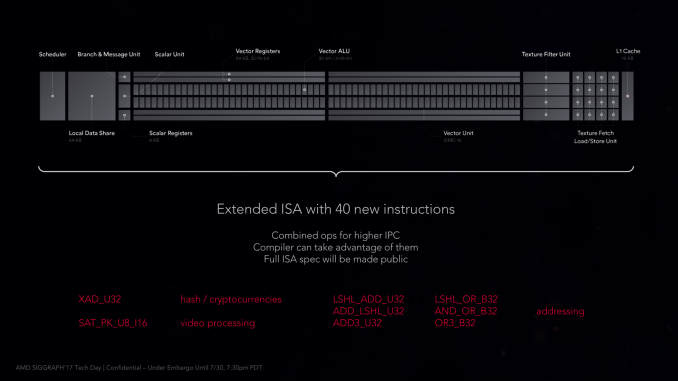The AMD Radeon RX Vega 64 & RX Vega 56 Review: Vega Burning Bright
by Ryan Smith & Nate Oh on August 14, 2017 9:00 AM ESTThe Vega Architecture: AMD’s Brightest Day
From an architectural standpoint, AMD’s engineers consider the Vega architecture to be their most sweeping architectural change in five years. And looking over everything that has been added to the architecture, it’s easy to see why. In terms of core graphics/compute features, Vega introduces more than any other iteration of GCN before it.
Speaking of GCN, before getting too deep here, it’s interesting to note that at least publicly, AMD is shying away from the Graphics Core Next name. GCN doesn’t appear anywhere in AMD’s whitepaper, while in programmers’ documents such as the shader ISA, the name is still present. But at least for the purposes of public discussion, rather than using the term GCN 5, AMD is consistently calling it the Vega architecture. Though make no mistake, this is still very much GCN, so AMD’s basic GPU execution model remains.
So what does Vega bring to the table? Back in January we got what has turned out to be a fairly extensive high-level overview of Vega’s main architectural improvements. In a nutshell, Vega is:
- Higher clocks
- Double rate FP16 math (Rapid Packed Math)
- HBM2
- New memory page management for the high-bandwidth cache controller
- Tiled rasterization (Draw Stream Binning Rasterizer)
- Increased ROP efficiency via L2 cache
- Improved geometry engine
- Primitive shading for even faster triangle culling
- Direct3D feature level 12_1 graphics features
- Improved display controllers
The interesting thing is that even with this significant number of changes, the Vega ISA is not a complete departure from the GCN4 ISA. AMD has added a number of new instructions – mostly for FP16 operations – along with some additional instructions that they expect to improve performance for video processing and some 8-bit integer operations, but nothing that radically upends Vega from earlier ISAs. So in terms of compute, Vega is still very comparable to Polaris and Fiji in terms of how data moves through the GPU.
Consequently, the burning question I think many will ask is if the effective compute IPC is significantly higher than Fiji, and the answer is no. AMD has actually taken significant pains to keep the throughput latency of a CU at 4 cycles (4 stages deep), however strictly speaking, existing code isn’t going to run any faster on Vega than earlier architectures. In order to wring the most out of Vega’s new CUs, you need to take advantage of the new compute features. Note that this doesn’t mean that compilers can’t take advantage of them on their own, but especially with the datatype matters, it’s important that code be designed for lower precision datatypes to begin with.











213 Comments
View All Comments
coolhardware - Monday, August 14, 2017 - link
I think that is actually why they went with that headline.As vladx's comment, AnandTech is not a joke. They put a lot of hard work into what they do and they have been doing it for decades. Anand's early work helped me build my first PC and they have continued to do a good job after his departure to Apple.
I for one am very appreciative of all Anandtech's efforts :-)
vladx - Monday, August 14, 2017 - link
"I think that is actually why they went with that headline."Nice spin, only a fool would buy into that sort of bullshit reasoning.
coolhardware - Monday, August 14, 2017 - link
Then I am a fool.Have a nice day :-)
sor - Monday, August 14, 2017 - link
That was actually the very first thing that came to mind when I saw the article "burning... I see what you did there".Oxford Guy - Monday, August 14, 2017 - link
You're not the only one.Ryan Smith - Monday, August 14, 2017 - link
I almost didn't go with that headline specifically because I was afraid too many people wouldn't get it.It's a shining moment for AMD in terms of architectural advancement. It's also a rather hot card in terms of heat dissipated.
vladx - Tuesday, August 15, 2017 - link
Like I said it's a really nice spin, if anything Polaris was the architecture that was shining brightly not Vega which is a clear regression compared to Fiji. So I'm sorry Mr. Smith, but I refuse to take you and any AT writer for that big of a fools and it's clear from other reviews as well that everyone is trying their best to polish the turd called VEGA.Beany2013 - Tuesday, August 15, 2017 - link
Narrator:In reality, VladX was incredibly hurt that he didn't get the joke, as so many others managed to, and had made himself look like a fool.
vladx - Tuesday, August 15, 2017 - link
A joke at AMD's expense is nothing to laugh about, so color me extra doubtful.FourEyedGeek - Tuesday, August 22, 2017 - link
Why be so immature?